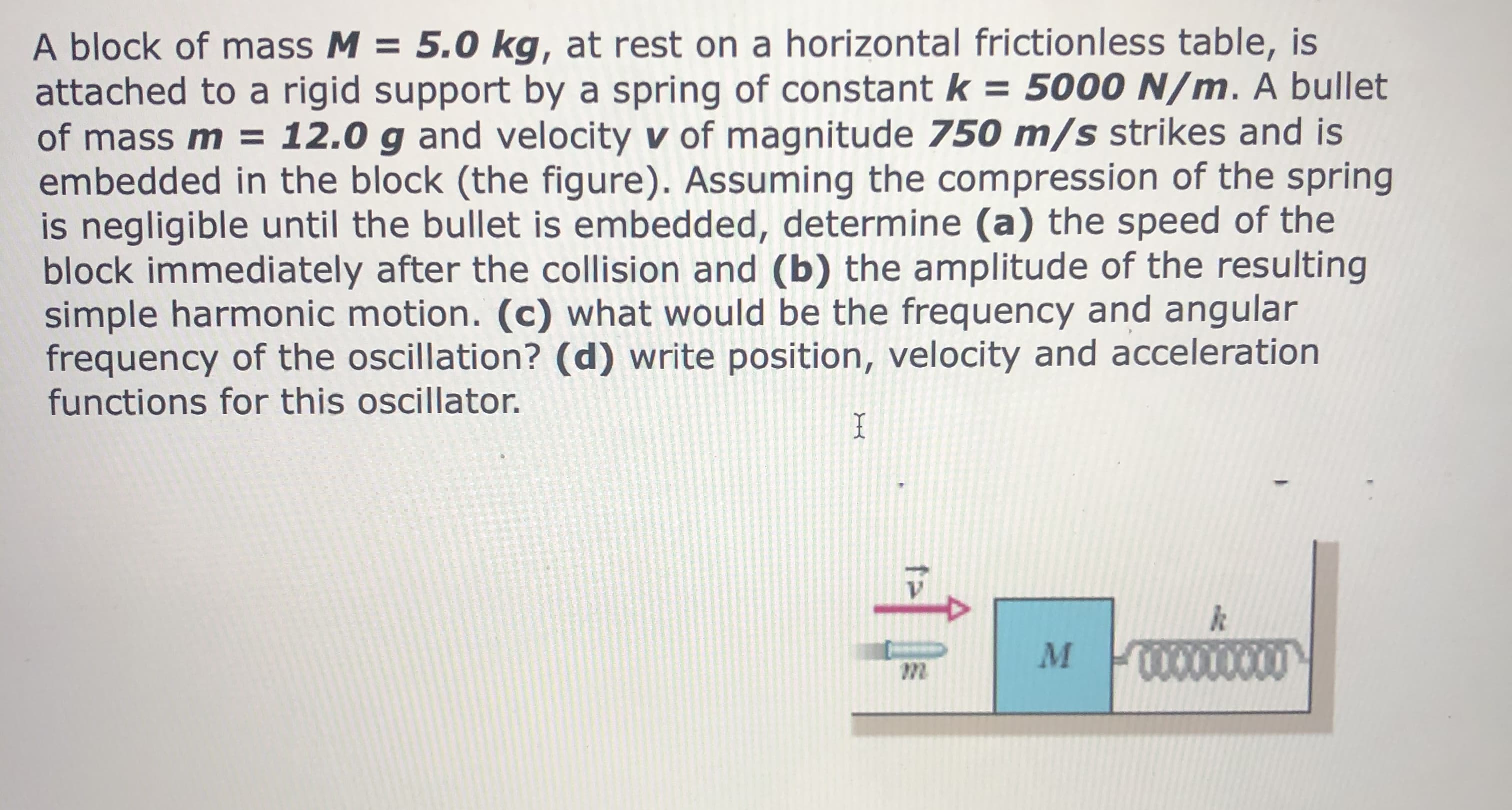A block of mass M = 5.0 kg, at rest on a horizontal frictionless table, is attached to a rigid support by a spring of constant k = 5000 N/m. A bullet of mass m = 12.0 g and velocity v of magnitude 750 m/s strikes and is embedded in the block (the figure). Assuming the compression of the spring is negligible until the bullet is embedded, determine (a) the speed of the block immediately after the collision and (b) the amplitude of the resulting simple harmonic motion. (c) what would be the frequency and angular frequency of the oscillation? (d) write position, velocity and acceleration functions for this oscillator. 0000000
A block of mass M = 5.0 kg, at rest on a horizontal frictionless table, is attached to a rigid support by a spring of constant k = 5000 N/m. A bullet of mass m = 12.0 g and velocity v of magnitude 750 m/s strikes and is embedded in the block (the figure). Assuming the compression of the spring is negligible until the bullet is embedded, determine (a) the speed of the block immediately after the collision and (b) the amplitude of the resulting simple harmonic motion. (c) what would be the frequency and angular frequency of the oscillation? (d) write position, velocity and acceleration functions for this oscillator. 0000000
Classical Dynamics of Particles and Systems
5th Edition
ISBN:9780534408961
Author:Stephen T. Thornton, Jerry B. Marion
Publisher:Stephen T. Thornton, Jerry B. Marion
Chapter12: Coupled Oscillations
Section: Chapter Questions
Problem 12.22P
Related questions
Topic Video
Question

Transcribed Image Text:A block of mass M = 5.0 kg, at rest on a horizontal frictionless table, is
attached to a rigid support by a spring of constant k = 5000 N/m. A bullet
of mass m = 12.0 g and velocity v of magnitude 750 m/s strikes and is
embedded in the block (the figure). Assuming the compression of the spring
is negligible until the bullet is embedded, determine (a) the speed of the
block immediately after the collision and (b) the amplitude of the resulting
simple harmonic motion. (c) what would be the frequency and angular
frequency of the oscillation? (d) write position, velocity and acceleration
functions for this oscillator.
0000000
Expert Solution
This question has been solved!
Explore an expertly crafted, step-by-step solution for a thorough understanding of key concepts.
This is a popular solution!
Trending now
This is a popular solution!
Step by step
Solved in 3 steps with 3 images

Knowledge Booster
Learn more about
Need a deep-dive on the concept behind this application? Look no further. Learn more about this topic, physics and related others by exploring similar questions and additional content below.Recommended textbooks for you

Classical Dynamics of Particles and Systems
Physics
ISBN:
9780534408961
Author:
Stephen T. Thornton, Jerry B. Marion
Publisher:
Cengage Learning

University Physics Volume 1
Physics
ISBN:
9781938168277
Author:
William Moebs, Samuel J. Ling, Jeff Sanny
Publisher:
OpenStax - Rice University

Classical Dynamics of Particles and Systems
Physics
ISBN:
9780534408961
Author:
Stephen T. Thornton, Jerry B. Marion
Publisher:
Cengage Learning

University Physics Volume 1
Physics
ISBN:
9781938168277
Author:
William Moebs, Samuel J. Ling, Jeff Sanny
Publisher:
OpenStax - Rice University